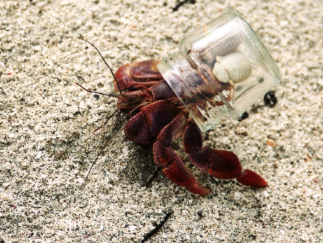
Is This a House for a Hermit Crab?

Overview
Students will use design thinking to build a house for a hermit crab or another animal.
Learning Objectives
Students will:
-
Understand design thinking
-
Understand empathy
-
Be able to have the knowledge of habitats design thinking to create a house for hermit crab or another animal.
Vocabulary
Vocabulary Words:
-
Design Thinking: Design thinking is a process for developing solutions to simple and complex problems.
-
Empathy: Empathy is to learn and understand; to be in their shoes.
-
Define: Define means to identify the issue/problem and solution based on needs and insight.
-
Inspiration: Inspiration is your why; source of interest, idea, question.
-
Ideate: To ideate/ create means to brainstorm and come up with creative ideas/solutions.
-
Prototype: Prototype is a representation of one or more of your ideas; draft or iteration.
-
Test: Test means to try your idea/solution for feedback; find out what worked and what didn't.
-
Refine: Refine means to fix and then go back to make changes (if necessary).
-
Science Vocab
-
Living things: Living things are things that are alive.
-
Non-living things: Non-living things are things that are not alive
-
Surroundings: surroundings are the things that are around where the animal or plant lives
-
Survival: Survival is the things that the plant or animal have to have to survive (food, water, shelter, and air)
-
Shelter: Shelter is the place that protects the animal when it sleeps or where lives (tree, cave, coral).
-
Habitat: A habitat is a place where an animal lives.
-
-
Science Concepts:
-
What do animals need to survive? food, air, water, shelter and the ability to adapt to environmental changes
-
What happens if an animal or plant's habitat changes and then cannot leave? It can adapt or if it does not adapt, it will die
-
Camouflage is when an animal is able to hide from its enemies by blending into its surroundings
-
What causes changes to habitats? Weather (season to season), fire and humans (pollution)
-
Pre-planning
To prepare for this lesson:
-
Some possible items needed:
- Cardboard
- Straws/ Strawbees
- Popsicle sticks
- Pipe cleaners
- Glue/scissors/markers/tape
- Yarn
- Construction paper
- Legos
- Pom poms
-
Watch video on Design Thinking.
-
The teacher may want to use the Design Thinking template.
-
Read, Is this a House For Hermit Crab. Story centers around hermit crab looking for a shell that fits him best.
-
Here is a video of the book being read with the illustrations.
-
-
Things to consider:
-
Time- this will take around 45 minutes -1 hour. If broken into stations, you could do this for a week.
-
Do you want students to work in pairs or groups of three? Groups past three students are not recommended.
-
Is this whole group or a station?
-
If it is a station, it is recommended that you explain design thinking and lesson as a whole before sending the students to the stations.
-
Will you assign an animal, or let students choose or have them design house for a hermit crab.
-
How do you want students to share out projects?
-
Flipgrid? SeeSaw? Present to class?
-
-
Accommodations
See Accommodations Page and Charts on the 21things4students.net site in the Teacher Resources.
Steps
Directions for this activity:
- Play the video or read the story to the students:
- Discuss Design Thinking
- What is it?
- Talk about the Components of Design thinking.
- The teacher says to the students, "Today, we will be making a home for ____________"
-
Show Design Thinking template to the students if they are going to use it.
-
Go over the ideas with the students. A good rule of thumb is to create a design thinking example for students as you go.
-
Things to consider for animals: habitat, climate
-
Decide who you are creating a house for?
-
Decide what functions you want for the house.
-
Use the design thinking template if applicable
-
Assessment Options
Different options for assessing the students:
- Observations
- Check for understanding
- Students can reflect on the project using this document.
- Students can also share out on SEESAW, Google Classroom, Flipgrid or Schoology.
- Design thinking template
MITECS Competencies & ISTE STANDARDS
MITECS: Michigan adopted the "ISTE Standards for Students" called MITECS (Michigan Integrated Technology Competencies for Students) in 2018.
Innovative Designer
4a. Students know and use a deliberate design process for generating ideas, testing theories, creating innovative artifacts or solving authentic problems.
4c. Students develop, test and refine prototypes as part of a cyclical design process.
4d. Students exhibit a tolerance for ambiguity, perseverance and the capacity to work with open-ended problems.
Computational Thinker
5a. Students formulate problem definitions suited for technology-assisted methods such as data analysis, abstract models and algorithmic thinking in exploring and finding solutions.
5d. Students understand how automation works and use algorithmic thinking to develop a sequence of steps to create and test automated solutions.
Devices and Resources
Device: PC, Chromebook, Mac, iPad
Browser: Chrome, Safari, Firefox, Edge, ALL
App, Extension, or Add-on:
Websites:
Is This a House for Hermit Crab video
CONTENT AREA RESOURCES
ELA
- Reflect on Project document
- Story Mapping
Math
Talk about sequential order of story.
Science
Students learn about oceans/ habitats.
Social Studies
Students learn about water pollution.
CREDITS
This task card was created by Courtney Conley, Utica Public Schools. January 2020.


